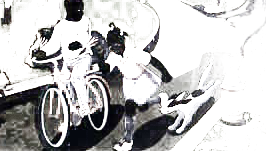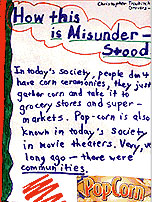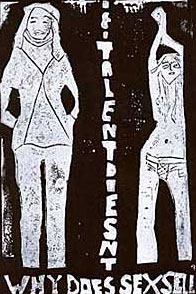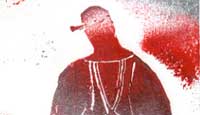Curriculum Guide
Single Subject: ART
by
Kyra Rice
|
Literacy Across Content Areas
|
|
"...You
just can't put a time limit on good teaching. You have to go with
it and see where it comes out. That's why a good teacher's planning
is only tentative. You can write all the behavioral objectives you
want. When the dynamic of a good class gets rolling, you can't know
where you're going to end up. You just have to trust that the learning
is worth it and that the kids have gotten something out of it."
Quote from from a teacher of African American students in The
Dreamkeepers, Successful Teachers of African American Children,
by Gloria Ladson-Billings
|
 |
|
Thoroughness in lesson planning is invaluable, while at the same time an educator must not dismiss the truth in the
quote above. As a way to address both good and thorough planning
as well as the issue of "flow" these lesson plans
offer a list of questions
to consider for a days activities and discussions rather than outlining minute by minute activities. The rigidity of minutes may throw this lesson off whereas the
questions allow for the pace to be adjusted according to students needs. |
|
LESSON PLANS day
1 day 2 day
3 day 4 day
5 |
|
Post
Card Exchange - autobiography and cultural identity
This
five day lesson plan is the first week of a longer term project
that will give students a better understanding of how their
particular cultural and personal experiences mold their perspectives,
create their sense of identity and influence the way they
make and interpret visual material. For grades 11 - 12, Art
II.
*Although
these lesson plans are integrated, lesson 1 and lesson 2 can
be taught individually, separate from this unit.
objectives
•
Students will research their background or every day experience
as it relates to their sense of personal or group identity.
•
Research and write about an artist's work that focuses on
issue of identity.
•
Translate meaningful personal experience into visual form
on their own set of post cards.
•
Students reflect on events in their pasts and connect their
particular experience with the choices they make as creators
and interpreters of visual material.
•
Address the problematic issues in design today like stereotyping,
appropriation and comodification of ethnic imagery
unit vocabulary
abstract, conceptual, eclips, formal elements, identity, polarities, relevance, strategy, stereo type |
|
Day
1: student identity research
materials
and resources
•
Student journals
•
list of identity research questions (listed below)
activities
Students
will be asked to write the answers of the following questions
in their journals (in a section dedicated to this project)
in order to begin the process of researching their sense of
personal or group identity:
•
Where did you, your parents, grandparents or ancestors migrate
from?
•
Does your family or extended family practice customs that
you value and/or identify with?
•
What language do you speak at home? What language do your
parents or guardian speak?•
What activities, sports, hobbies do you engage in regularly?
•
Does what your parents or guardian do during the day have
an effect on how you identify yourself - as similar or in
contrast to?
To
further facilitate student identity research students will
break into small groups of three or four and share what they
wrote down for answers to above questions, discus their answers
with others, and ask any questions of each other that they
may be curious about. Allow at least 20 minutes for this. After
group sharing, student will work independently in journals
answering the following questions:
-
Is there another within your group that you identify with?
-
Did you learn about another student's personal or cultural
identifiers that are new to you?
- Do you share any identifiers in the same way or in a different
way with another in your group? In other words do two students
share a similar identifier but identify themselves with it
differently?
After
journal entry, students select both a location and an event,
activity or phenomenon that relates to their sense of personal
or group identity. Students create a list of descriptive words
as it relates to their identifiers. For example, the name
of a place, the colors of a flag, the name of a language,
the color of ones eyes, a habit, a preoccupation, a religion,
etc.
homework
explanation
For
day 3: Drawing from their word lists created in class on day
1, students research their "personal identifiers."
Students can research ethnic origins and racial identities,
and explore the traditions and oral histories of their families
and communities. OR students can focus on the minutiae of
their daily lives as a way to investigate their sense of individual
identity. Students will take photographs of, make sketches,
or bring in objects that speak as personal or group identifiers.
(One
50 minute class period.)
Fulfills
CA
State Board of Education Standards for Advanced Visual Arts:
3.3.
top |
|
Day
2: identity and contemporary art
materials
and resources
•
computer lab with Internet access and projection capabilities
and Quicktime to show video clips of following artists whose
work addresses the issue of identity: Louise
Bourgeois, Maya
Lin,
Bruce
Nauman, Kerry
James Marshall, (from the Art:
21- Identity and Contemporary Art Web site).
•
Homework assignment printed for hand out with questions and
guidelines for reviewing an artwork (below).
•
student journals
activity
In
the computer lab, students and teacher as a group will read
about and watch the video clips of artists. Discus and take
notes on the following questions that relate to each one:
1.
Bruce
Nauman: go to link, have a student read out loud about
artist, then view Model for "Stairway" VIDEO clip. Teacher
will read artist's quote: "I needed a different way to approach
the idea of being an artist. I always thought that you can
make something that appears to be functional, but when you
try to and use it, you can't figure out what its function
might be. And that's in the end what the function is, for
you to figure out what to do with it."
Discussion
questions:
•
How does this statement relate to identity?
• What is the significance of the stairway as it relates
to identity in toady's world?
2. Maya
Lin: go to link, have another student read about Maya
Lin, then view "Ecliptic" Ice Rink VIDEO clip and Making
Atlas Sculptures VIDEO clip.
Discussion
questions:
• Define the word "polarities" as it relates
to Maya Lin's two works Making Atlas Sculptures and "Ecliptic" Ice Rink.
• How does her use of polarity speak to the issue of
identity?
3. Kerry
James Marshall: go to link, have a student read about
Marshall. View "Many Mansions" VIDEO clip, "RYTHM MASTR"
comic VIDEO clip, Family Greeting Cards VIDEO clip, and
"Portrait of the Artist..." VIDEO clip
Discussion
questions:
• what sort of conventions did Kerry Marshal have to
adopt in order to reclaim the Black identity as one that is
powerful?
•
what technique has Marshall used to create a powerful representation
of Blackness in his paintings?
•
why was it important for Marshall to reclaim the Black identity
in the world of art?
• what cultural identifiers, does Marshall use to portray
powerful black supperheros?
4. Louise
Bourgeois: go to link, have another student read about
Louise Bourgeois. Then go to
Women and Craft VIDEO clip and view.
Discussion
questions:
• What era was Bourgeois getting her arts education and
does that have an effect on the content of her work?
• What does she have to say about women's' roles in general?
further
investigation
If
time allows look at some student works that deal with identity
and Native American stereo types at the Student
Projects site of Art: 21.
homework explanation
Choose
one of the art works that we looked at today, or an art work
that we did not look at today that you think deals with the
issue of "identity", and write a review the piece.
If you choose another artwork that we did not discus today,
you must attach an image of the artists work. One page minimum,
typed, double spaced. The following questions should be addressed
and used as a guideline for your review:
•
Describe the piece: medium, formal elements of the work, size
or scale, content.
•
Based on what we discussed during presentation of the artists,
how are they addressing the issue of identity?
•
What formal, visual, and conceptual strategies does the artist
use to do this?
• Three days to complete assignment
(One
50 minute class period.)
Fulfills
CA
State Board of Education Standards for Advanced Visual Arts:
1.2, 1.3, 1.5, 1.6, 1.8, 3.1, 3.2, 3.4, 4.1, 4.2, 4.3, 4.5,
5.2
top |
|
Day
3: design for identity
materials
and resources
•
List of things to consider for post card designs for identity,
printed and enough copies to give one to each student.
•
Students' word lists, items collected and/or images of identifiers
students bring from homework
•
card stock cut into 4" x 6" size. There should be
enough to provide all students in class with 3 each.
•
pen and ink, pastels, acrylics, water color, colored pencils,
graphite pencils•
Student journals
activity
With the same small groups they worked with on day 1, students
will present their list of words, and the stories, images,
sketches and/or objects that relate to meaningful personal
experience as a pre-discussion to clarify "what's what"
as it relates to how they identify themselves. Do two students
share a similar identifiers but identify themselves with it
differently?
3
sheets of 4" x 6" post card stock will be distributed
to each student. Working
individually students will draw from word list, stories, items
and images they brought in to translate the meaningful personal
experience into a visual form/design on their set of post
cards. The design they come up with will encapsulate their
personal identity research. Things to consider for designs:
•
Will you use post cards all as one larger canvas that can
be pieced together? If so, each must stand on is own as
a design.
• Will you use the three post cards as a series?
• Will each one represent something different?
• Make sure that each post card speaks to the other two
in some way, that the three are not in isolation of one another.
• The three post cards are to represent the one message
of meaningful personal experience.
• Will you have literal representation or will you abstract
an essential part of an issue to symbolize and speak to other
images?
• Will you use both sides of the post card? if so what
message are you conveying about yourself that using both sides
addresses?
• Try to make each element in your design be relevant
to the issue of identity.
Students
will write their name and address down on a piece of paper
to be exchanged with the name and addresses of one other student
in a different period art class that is doing the same project.
The three post cards will be sent to the person with whom
students exchanged addresses with in another session of this
art class. (Ideally students will exchange addresses with
students in another school, and even ain another state.)
After
design portion is introduced, students are to work in class
on drafts for their designs. Students are to decide what medium will
they will be using; i.e., pen and ink, pastels, acrylics,
water color, colored pencils, graphite.
(One
50 minute class period.)
Fulfills
CA
State Board of Education Standards for Advanced Visual Arts:
2.1,
2.2, 2.4, 2.5,
top |
|
Day
4: design for identity - written form
materials
and resources
•
pen and ink, pastels, acrylics, water color, colored pencils,
graphite pencils
•
Student journals
•
List of things to consider for post card designs for identity
activity
Present
drafts of designs, or incomplete finals of three post cards
for class critique. For the critique we will refer to the
List of things to consider for post card designs for identity,
(provided on day 3) to guide the critique.
From
insights and constructive criticism gained from class critique
of their designs as well as from their original research,
students will write text relating to their topic. This text
will be written on the back of the postcards describing their
design. Students are to address why they chose the imagery
they did, and how the imagery speaks to the student's personal
identifiers. Students
should work on written text or final post card design for
the remainder of class time.
(One
50 minute class period.)
Fulfills
CA
State Board of Education Standards for Advanced Visual Arts:
4.4, 4.6, |
|
Day
5: post card exchange
materials
and resources
•
postal post card rate stamps enough for each student in class•
pen and ink, pastels, acrylics, water color, colored pencils,
graphite pencils
•
Student journals
activity
Turn
in review of art work (homework from day 2).
Students
are to complete their designs on all three post cards. Students
are to complete text and exchange with another student to
proofread. Write
text onto backs of post cards.Post
and send post cards at the nearest mail box. Getting
students out of the classroom to send the postcards during
school will emphasize the point that these designs will be
seen outside of the context of school and this class room.
Students will receive post cards of another student's design—who
they may not even know—at their homes in the mail. It
will be in the context of the student's own home that they
will get the first impression of the other's design and will
read about them.
(One
50 minute class period.)
Fulfills
CA
State Board of Education Standards for Advanced Visual Arts:
4.4, 4.6,
further
reflection for critique of final postcards sent and received
•
The following week each student will receive three post cards
from a student in another section. Once all of the students
have received the post cards, via USPS, both classes will
merge for presentation, critique and discussion. Students
will present the post cards they received, read text and describe
their findings. Then the class as a group will critique each
one after presented.
•
Is imagery stable as they travel from maker to receiver across
geographic, cultural, and individual boundaries?
•
Did the receiver learn more about the visual expression of
his own specific cultural group, that went beyond the intent
of the designer
•
Discuss inappropriate commercial uses of culturally charged
or sacred images in the mainstream. |
|
top |




